我們都去過那裡-您找到了一個帶有如此引人注目,引人入勝的故事,您無法停止觀看……但看起來絕對是垃圾。也許角色設計很糟糕,也許動畫非常低,也許做出了令人困惑的顏色選擇,或者也許是三個,還有更多邪惡的視覺選擇。但這沒關係;您迷上了,因為故事本身是如此的好。我們要求社論團隊提出他們嚴格觀看故事的動漫例子。您是否同意他們的選擇?
lucas deRuyter
毫無誇張地說,狂暴漫畫在西方地區的漫畫中發揮了關鍵作用。漫畫的黑暗幻想環境,慢燃燒的報仇對自我實現的情節,華麗的藝術品和糟糕的動作引起了所有背景的國際觀眾。甚至在2021年MangakakentarōMiura過時的過去之前,狂暴漫畫就被公認為在媒體上是一項獨特的成就,並在全球範圍內慶祝。
我知道,狂歡者在2016年大學二年級後的夏天要多大。通過我的動漫俱樂部出勤率和我遵循的社交媒體帳戶,通過此續集動漫對狂暴動漫的期望是可顯而易見的。因此,我做了對動漫,漫畫和媒體批評充滿興趣的任何人,並試圖在新動漫發行之前趕上該系列。該學期的決賽結束後,我會在我的櫃檯工作中頻繁的緩慢時期閱讀漫畫的失落兒童章節。在視頻群聊和夏季課之間,我觀看了整個轟動的1997年狂熱動漫,該動畫(卻是莫名其妙地)上傳到了YouTube上。
然後,7月1日到處走來走去,我現在準備好跳入並完全在情感上投入到狂熱者,並簽署了Crunchyroll觀看這款新動漫,而且……這很糟糕。
許多才華橫溢的人為解釋了Berserk(2016)如何令人失望,並調查了為什麼這是對這種備受喜愛的作品的改編而來的。我不會在這裡保留所有這些,但是總而言之,Berserk(2016)並不是失望,這僅僅是因為它的視覺效果未能辜負Miura的令人嘆為觀止的動畫。從聲音設計到鏡頭組成的每個部分都是業餘或無能的。儘管人們對演出的CGI動畫的使用持謹慎樂觀,但考慮到工作室4°C Berserk的表現如何:黃金時代的弧線電影在播放結束時看上去,但很明顯,Studio Gemba和Millepensee的綜合努力與電影的質量無法匹配。
儘管有環球平移,但我繼續觀看《狂戰》(2016)動漫。沉沒的成本謬誤對我掌握了,我不得不知道狂暴的故事接下來是在哪裡。通過泥土塗層這部動漫,使米魯阿(Mirua)的漫畫如此特殊的人類精神的反思得以閃耀。在這個季節,我看到膽量從不斷的報仇劑轉變為卡斯卡掙扎的看守人,並開始學習如何從他的創傷中康復,而不僅僅是面對面。我看到膽量開始通過Isidro,Farnese和Serpico等同伴的同伴開始重建他的社區。我看著格里菲斯·克勞(Griffith Claw)離開地獄,開始在他以前的鷹樂隊的屍體上建造烏托邦。最後,我看著每個角色都努力應對幸福的樣子,以及他們在一個以破碎的暴力和苦難為標誌的世界中找到它。
我在第一個賽季包裝後沒有繼續觀看Berserk(2016)。即使到了最初的賽季結束時,我也讀過漫畫中故事的那部分。我將為動漫而慈善,並承認它試圖適應漫畫的範圍標誌著該系列中的一些大調動,因此,即使是最熟練的生產團隊,也總是會構成一些重大挑戰。我將永遠建議人們讀《狂暴漫畫》,或將腳趾浸入1997年的動漫系列中。
但是,我的一部分總是很高興Berserk(2016)存在,因為這是我花費大量時間來體驗一項既在其媒介中既開創性又具有文化影響力的作品的動力。是的,我觀看了Berserk(2016)的故事,但也可以與其他人一起體驗一代世代相傳的藝術作品,該藝術將塑造為人類其餘的存在而塑造講故事的藝術。
去閱讀狂暴漫畫!
rebecca silverman
這是BL動漫迷熟悉的進入的進入障礙。幸運的是,自從學校保姆以來,它不會破壞最甜蜜的家庭故事之一。 (這看起來也不是很棒。我正在感覺到另一種模式。)塔達瑪(Tadaima)中心的主題,奧卡里(Okaeri)是一家人,無論是生物學還是發現的。 Masaki和Hiromu是一對不尋常的Omega/Alpha品種的已婚夫婦,這意味著他們有親生的孩子。起初,他們的兩個家庭都反對他們的婚姻,Masaki的家人更加擔心他,而Hiromu的一面更加卑鄙。儘管他們愛父母,但兩個人也對自己創造的家庭完全滿意,尤其是與孩子,長子hikari和後來的女兒hinata。抽獎不是兩個人是共同育兒的。一個熱情而充滿愛心的家庭正在度過他們的日常生活,彼此互動,周圍的人逐漸建立自己的更大的,找到的家庭。雖然有焦慮,但這不是情節的驅動因素。
儘管有時是柔和的粉彩調色板,但塔達瑪(Tadaima),奧卡里(Okaeri)是終極舒適,感覺良好的表演,但這只是每個人一生中所經歷的。即使您更喜歡寵物對孩子們,也看著希卡里(Hikari)給隔壁的狗寫一封信(他最好的朋友,他也害怕他)很可愛,而Masaki和Hiromu在小說中做了最不尋常的事情:當他們遇到問題時互相交談。從最純粹的意義上講,這是生活的片段,這個故事歡迎我們成為一個家庭,並允許我們分享他們的一生。是的,看起來很糟糕。是的,這是omegaverse。但是,更重要的是該系列的溫暖和舒適的方式使我們相信,最終一切都會好起來的。
Richard Eisenbeis
Partners
所以我是蜘蛛,那呢?是過去十年中我最喜歡的幻想故事之一。它從Isekai類型的喜劇轉折開始,在那裡我們的主人公是世界上最危險的地下城深處的蜘蛛怪物,而她的同學則成為騎士和貴族。演出的大部分時間都遵循庫莫科逐步逐步向上移動食物鏈的生存之戰。很明顯,事情遠非出現。誰是英雄,誰是反派的人,甚至是世界的本質,具有遊戲般的魔術系統,也成為一個要解決的謎團。更好的是,整個第一個季節都是圍繞著精心製作且實現的講故事的技巧,直到系列的最後一集才完全透露。但是至於外觀……好吧,我想現在是時候提到它是由Millepensee動畫的,由Shin Itagaki執導,就像2016年的狂歡者一樣。
觀看第一集,甚至是第一個半賽季-所以我是蜘蛛,所以什麼?您可能會震驚地在此列表中找到它。儘管從一開始就有很多低於PAR的CG(以及多個外觀不錯的CG),但它用來使怪物動畫的事實隱藏了它的質量高度。但是,一旦我們的蜘蛛俠離開了她的地牢的範圍,越來越多的戰鬥包括人類角色,瑕疵就會變得明顯和徹頭徹尾的痛苦。
在最後幾集中,動作畢業於史詩般的戰爭場景,事情在CG陣線上達到了最低點。主要角色的3D模型與他們的2D藝術形成鮮明對比,並且在戰場上抄襲了無數的同一士兵或兩個士兵,以執行機器人的行動。看起來最糟糕的事情是某些場景中的背景。要說它們看起來像PS1圖形,其不自然平坦的幾何形狀和單一的微小紋理塊重複的AD Infinitum將對那個時代的遊戲侮辱。即使節目試圖使用3D動畫做一些很酷的事情,例如移動或旋轉的鏡頭對於真正的相機是不可能的,幀速率也會落入單個數字中-讓您想知道它是否是計算機或平板電腦的問題,而不是動畫。隨著故事越來越接近其最終高潮,實際動畫變得越來越稀疏。我們在靜態框架上得到鍋,以使運動的幻想,甚至讓角色在沒有顯示嘴巴的寬闊鏡頭上說話,沒有任何動畫。即使事情在移動時,我們也有諸如荒謬的射擊作品,對角色的怪異的眼睛以及缺乏誠實愚蠢距離的角色的細節的問題。
所有視覺上的負面影響以及您可以在故事中閱讀小說系列的事實,您可能會想知道為什麼要看這一點。答案很簡單:aoiyūki。這些動漫的大部分是一個單人表演,其中心是AoiYūki的Kumoko。我們只有她的獨白可以與觀眾聯繫,她提供了名副其實的巡迴演出。喜劇和危險都可以完美地散發出來,而且不可能紮根於可怕的庫莫科(Kumoko),即使她做了不斷繁多的事情。這是一種值得一遊的動畫的體驗,我鼓勵每個人都自己體驗。 Height=“ 338”>
©2006 竜騎士07/ひぐらしのなく頃に製作委員會・創通
Higurashi的大部分影響來自其曲折和技巧,這是可恥的,就像您永遠不應該破壞您第一次看著Psycho或Wicker Man的人一樣。 (您是什麼意思,哪一個?)正如這些比較所暗示的那樣,Higurashi是一個恐怖系列。它的早期情節講述了一個熟悉的令人毛骨悚然的故事。一個男孩凱伊奇(Keiichi)搬到一個偏遠的日本鄉村村莊,遇到了可愛的當地人,尤其是他學校的嬉戲女孩-並與他們一起參加hijinks。誠然,那是在一個閃爍的序言之後,我們在苦惱的情況下看到同一個男孩。 涉及一隻棒球棒,血液-鮮血和大量的血液。嗯,我敢肯定這並不重要。
早期的場景感覺就像動漫后宮的欺騙。當一個被活潑的女性包圍的男孩帶領他進入他們鎮上的神話和奧秘時,出乎意料的危險是什麼?隨之而來的是非線性講故事的大師班,跳過了觀點和時間表,但仍保持參與和上癮。 Higurashi的主要技巧即使在2006年也不是新事物。令人眼花azz亂的是該節目圍繞它的精美。
該系列由幾個多節目的故事情節和角色驅動的恐怖故事組成,以同一故事為例。它們非常複雜,以至於您開始仔細閱讀每個細節。這些故事都涉及鄉村小鎮,主要是在同一夏天。他們承擔著相同的角色-大約十個重要角色,包括凱伊奇(Keiichi)和各種女孩。
這些角色從根本上行事-儘管從來沒有不可能-從一個故事到另一個故事。兇手成為英雄,然後又是兇手。惡棍成為受害者。角色在一秒鐘內從友好轉變為恐懼。禁忌真理的獵人消失或生氣。我應該強調這是恐怖。有很多流血的暴力,有些是對令人震驚的微小受害者的反對,儘管即使是恐怖的場面也經常違反酷刑色情規則。許多受害者拒絕將自己視為受害者,在切成薄片和撕裂時保持反抗。有更多幽默的恐怖。一個中間情節涉及一個充滿“完美”的謀殺案。
這個出色的系列是用草率,易碎,粗略的繪畫來講述的,由Studio Deen提供。我可以理解任何在掉頭之前就丟下Higurashi的人。但是,仁慈的是,該節目的指導足夠多,可以超越笨拙的態度,並以歇斯底里的扭曲面孔和巧妙地編輯了懸念和暴行。它也有一個很棒的標題序列,在屏幕上露出花花公子的花朵在屏幕上凝視著花朵,他們的臉沾滿了眼淚或血液。
Jean-karlo Lemus
src=“ https://www.animenewsnetwork.com/thumbnails/max600x600/cms/feature/221830/eatman03.png.jpg.jpg.jpg” width width=“ 600” 600“ 600” 600“高度=” 460“ 460”>正如賈斯汀·塞瓦基斯(Justin Sevakis)所說的那樣,馬希莫(Mashimo)1997年的《飲食改編》(Eat-Man Aftaptation)是,只有在您想破產時才釋放的那種東西。它是對Akihito Yoshitomi 1996年漫畫的良好改編嗎?不;動漫僅採用漫畫的最基本元素,然後將它們撒在稀疏的周圍。它保持了主角螺栓曲柄和他的兩種能力(吃不可食用的工業碎屑,並用手召喚完全成型的武器)。否則,它完全放在Lam上。
看起來不錯?不;該節目的預算有些,因此採取了許多動畫快捷方式。該節目並沒有充滿動蕩的槍戰,鮑爾特(Bolt)從他的手中召喚了大量的世界末日槍支,而是使用了許多緩慢的鍋和停頓來弄清楚其情節-幾乎令人沮喪。該節目喜歡暫停看似隨機的圖像,因為感覺太長了。
,但這一定意味著故事很好,對嗎?不完全是;伊特曼(Eat-Man)是1970年代令人難以置信的綠巨人的絕對情節敘事。鮑爾特曲柄徘徊在某人的生活中,以全能的貿易千斤頂提供服務,發生了事情,螺栓徘徊在後世界末日的荒原上,被毀壞的太空飛船籠罩著天空。故事會得到幸福的結局嗎?他們得到了結局,就足夠了。
表演會很爛嗎?不,伊特曼遠不止其零件的總和。我的理解是,Eat-Man是一部動漫,播出了我喜歡稱為“ Otaku o’Clock”(凌晨1點)的動漫。這是一個利用那個時間段的節目。凌晨1點,塵土飛揚的視覺效果和緩慢的平底鍋使該節目令人震驚。每一眼目光都會偷走發生的一切,感覺更有意義。每次您看到它們時,重複的切割和閃回都會充實,每週戲劇越來越多地填充空白。每個陰暗的人物本週隱藏的無助Waif都更加可怕。這是一種回想起電視時代的語氣,如果允許,您可以坐下來沉迷於節目的共鳴。我們對螺栓知識一無所知,但這幾乎沒關係。我們被人的螺栓互動,而是有幫助的,那些早在他們之前已經過去的人留下的奧秘,以及他們在絕望的世界末日世界中過著的生活。在某些方面,這有點像動漫在黑暗塔的中世紀的一片壽命表演中:世界已經發展,但是那些生活在其中的人繼續興奮。動畫更好,顏色更亮,故事相互融合,而不是情節的蓬鬆狗故事,而且它們都做得更好,可以將漫畫的故事捆綁在一起。然而,原始的飲食人是我喜歡的。它的缺陷導致了令人難忘的東西,我在其他任何地方都找不到。有時,少的實際上是更多。元素ap
這樣的項目可能很有趣,因為它們促使我深入到我的思維宮殿深處,並回想起我從那以後沒有太多理由考慮的動漫。 “對,”我告訴自己,“有些節目我清楚地記得它的動畫包含了很多外殼。我可以回想起與朋友進行專門交談。這又是什麼?”當然,這是《暮光之城》中的幻影,這是2018年超自然的反向哈雷姆的故事,因為炎熱的行業趨勢與中國動畫製片廠相結合。它正在席捲整個國家。有些劇集甚至很精緻!在所有方面都有一種風格的感覺,這是一種很酷的感覺,這是有意義的,鑑於出售狼人和吸血鬼等的熱男友的表面吸引力。但是,暮光中的幻影幾乎一直很僵硬,當它不存在拋光劑時,角色模型在屋頂周圍滑動的焦慮而不是焦慮的狼男孩的動力。視覺效果趨向於廉價和庫存,以及許多倉促的,經常令人困惑的編輯都將所有這些融合在一起。這200%不是我正在觀看視覺效果的節目,這很有趣,因為“看起來很性感”應該是像這樣的系列存在的全部原因。
我在暮光中看什麼是什麼?簡而言之,這只是很有趣,主要是因為其角色及其某些選擇在類型上相當獨特。所謂的主要事件的環球怪物Gijinkas並不糟糕-儘管在幾乎沒有登上模特的系列賽中,我敢肯定的是,江西男孩Tauryu從來沒有被正確地繪製。向熱狼人盧克和他的兄弟克里斯大喊,它們看起來像是不存在的王國之心版本。真正的吸引力是女主人公,儘管這並不是唯一強大的反向哈雷姆領導者,但尤其是很棒。噸重的方式,管理和整體處理浪漫軌道上的怪物男孩,尤其是她那可能是危險的男友吸血鬼弗拉德(Vampire Vlad),令人難以置信地看到。她在用這種生病的超自然多鏈武器和發光的紅色頭髮與她看起來超級酷的紅色頭髮時做到了這一切。或至少像該節目的藝術所允許的一樣酷。
最重要的是,暮光中的幻影是一個女孩后宮系列,也足夠勇敢地成為尤里。實際的情感核心是噸,她的特別朋友Shinyao做了一個galsing-pals的事情,該事物始於“對此沒有異性解釋”的水平,只從那裡升級了浪漫。 Shinyao獲得了大部分節目的大部分時間,而Ton試圖營救她,所以我認為,他們意識到自己的關係將壓倒與男性恐怖的怪物手冊一起運送噸的任何可能性。它主要是有效的,因為這一切都與《暮光之城》中的認真,有趣的愚蠢幻影相結合。如果噸涼甚至少20%,那將是令人沮喪的,如果看起來更好,可能會讓我退出演出。每當角色模型轉變為詹克(Jank),或者有一個不明智的荷蘭角或擦拭過渡時,它就使我想起了這項練習的毫不留情,這說明了為什麼有時有時候7/10比任何完美的Prestige生產更有趣。
caitlin Moore
src=“ https://www.animenewsnetwork.com/thumbnails/max600x600/cms/feature/221830/screenshot-2025-03-03-09-09-163535.png.jpg.jpg.jpg.jpg.jpg”在某些圈子中的意見不受歡迎,但動畫質量很重要。就像強大的視覺效果可以提昇平庸的故事,無靈感的方向和僵硬的角色可以主動妨礙視覺講故事,從而拖延整個作品。我要坐下來花很多時間,讓我的時間放到一個糟糕的演講中,尤其是因為我幾乎沒有時間在我想看的兩個方面都有很強的時間。儘管如此,每隔一段時間,一個人都會出現足夠引人注目的人,可以讓我觀看。結果,該國被婦女經營,而男人被視為商品。如標題所示,故事的重點是幕府法院,特別是內部庭院-ōoku,除了幕府將軍,任何人都無法接觸到數百名男子。 Yoshinaga使用該環境來探索在這種情況下社會權力動態將如何變化,考慮並納入了各種因素,而不是製造出與父權制在功能上相同的矩陣外,除了女性負責。
其包含在此列表中,暗示著動畫不錯。角色動畫是僵硬的,故事板是Yoshinaga鑲板的無藝術直接副本,而無需考慮對圖像的佈置方式以及從一種媒介到另一種媒介的轉變的意圖可能會影響觀眾的接收方式。 However, outside of one or two unintentionally funny erotic scenes where it looks like the couple on-screen is attacking each other’s faces rather than caught in the throes of passion, the poor production doesn’t hold it back as much as some of the other series I considered for this list, such as Farewell, My Dear Cramer.
The first is that this truly is the kind of story driven forward primarily by people sitting in rooms talking.畢竟,這是法院陰謀的故事,許多角色都處於避免身體衝突的位置。緊張局勢沒有採取行動,而是源於觀看人類在絕望的情況下掙扎,在他們騎馬爭奪他們能找到的任何權力時,他們被困,謀殺和陰謀。這是矛盾的情緒和短暫的聯繫。雖然美麗的動畫無疑會支持這些故事,但它本身就足夠了。
作品的另一個救贖是真正令人難以置信的聲音演員,可以提供這些台詞。 Yoshinaga的出色著作以人聲表演為生,包括行業傳奇人物Kikuko Inoue,Mamoru Miyano和Seki Tomokazu。每個角色都是複雜的,涉足一個具有競爭性的個人動機和社會義務的世界。每個配音演員都以多層表演來實現自己的角色正義。 Miyano作為Arikoto的表演,Arikoto是一個綁架並被迫成為最早進入ōoku的男人之一,其中包括我仍然可以在腦海中聽到的線條讀物,即使在觀看節目後一年多了。
oltoku是動畫,我可以將其與“我一起看這個故事”的含義。直接地,它只是一個非常好的故事,值得一看!它寫得很好,主題上很富有!在第二個,Snider的解釋中,視覺呈現嚴重缺乏,沒有人會觀看動畫。不過,Yoshinaga令人難以置信的講故事使一切都值得……尤其是如果您負擔不起漫畫。
Jeremy Tauber
©lynn Okamoto•Shueisha/VAP•Genco
我確實看了Elfen為其故事撒謊,但不是因為我認為它很棒。這是因為它的危害是如此平淡無奇,以至於我忍不住看著其餘的。問題?我在錯誤的時間看了。作為一個庇護的孩子,他的家人禁止他玩M級遊戲,並留下了刺猬Gamecube遊戲的陰影,作為前衛的代理,我敢肯定,Elfen Lied並列了Kawaii Moe,圖形暴力和圖形暴力會為我帶來奇蹟。但是,在動漫的現象消失後的幾年後,我看了將其釋放近十年後觀看。我不再是一個少年,只有21歲的大學,我的學校的Uber-Macho足球和啤酒時代精神讓我進入了180年的生活。這就是為什麼Elfen Lied如此有爭議的原因。如果您可以將自己置於00s時代的emo少年的心態,則可以使用。如果不能,您會將其視為胡說八道-福音-發條橙。對我來說,這是兩者兼而有之。
Elfen Lied仍然是有史以來充滿電波的最前衛的動漫之一,它的第一集將永遠被人們銘記為對於那些認為動漫是Pokémon和Sailor Moon之類的無害兒童的分水嶺。但是,它的前衛幾乎沒有得到任何知識分子的支持。並不是說您可以從Jekyll和Hyde Plotline中擠出任何光彩,但我認為,當您要求無償暴力,性行為和人性化以使其不僅僅是窗口盛裝時,它不會要求太多。露西來回從幼稚的失憶症轉變為討厭人類的冷血殺手。最糟糕的人類在這里和那裡都顯示出來,而OP的死亡使人陷入困境。節目的其餘部分及其角色在主題上感覺很淺,被日期00s-y的動畫澆水,像幻想小說一樣閱讀了一個十四歲的年輕人會為媽媽紮根一個星期而發怒。當它的故事沒有被鮮血浸透時,它看起來很尷尬且無意間很有趣。
,但是,該節目是一種有罪的樂趣,所以我會給它帶來應有的榮譽。它確實通過使動作Ultraviolent和一些場景令人不安的動作來達到爭議。露西的角色設計和該節目的恐怖美學可能有助於讓位於Madoka和School Live!英語配音並不是最拋光的,但仍然做得很好。儘管發生了變化,但這還是很準確的,儘管宣誓就不需要。我沒有被它冒犯-我來自費城。粗俗只是這裡的白話的一部分。不過,當一個壞傢伙發誓像水手一樣使他看起來更加拮抗時,感覺如此僵硬,以至於我每次都忍不住笑了。同樣,這可能會讓我著迷於青春期的未成熟。但是,在成年後重新觀看了這個系列的重新觀看,對話讀起來就像是一個壞喜劇演員,他認為添加更多的誓言會使他的行為更令人難忘。
在早期的《奧格特》中發布的
,埃爾芬·撒謊仍然是當時的熱門話題的產物,而蒂姆·伯頓(Tim Burton Rena)仍然在拐角處。享受今天撒謊的精靈是回顧那個時代,而數十個逃生的AMV在其後產生了。對於那些對2000年代動漫的懷舊之情,Elfen Lied的故事仍然值得研究,即使它沒有結束。
reuben baron
©2006 kadokawa shoten/歡迎對N-H-K Partners
很久以前就將其簡化為先令NFTS,Gonzo Anime Studio在視覺上雄心勃勃的預算和當時的cg cg效果的視覺上雄心勃勃的作品而享有聲譽(他們使用的是cg效果(他們都稱為“ dikim)”(他們都稱為“ Gonz”)。 2000年代的CG並不總是年齡最好的,但是努力是在那裡,而《最後的流放》,《甘庫舒》(Gankutsuou):蒙特克里斯托(Monte Cristo)的伯爵(Monte Cristo)和Afro Samurai的伯爵(Afro Samurai)今天仍在視覺上保持視覺效果,這要歸功於出色的設計工作和令人印象深刻的手繪動畫。歡迎來到NHK,這是2006年製作的九種動漫奇聞趣事,即工作室從其名稱中刪除“數字化”兩年後,這不是錄音室在動畫方面的首要任務。人們可能會希望該系列比奇聞趣事更富於效果的票價至少可以具有視覺一致性,但沒有。動畫質量在整個過程中都可以上升和向下,最多達到“可傳球”的高度,並落入最壞的情況下陷入非模型塗鴉(而不是有趣的藝術類型)。即使在模型上繪製,角色設計也是Yoshitoshi abe插圖Tatsuhiko Takemoto的原始光小說的通用降級。
我敢打賭,歡迎來歡迎NHK的視覺問題是第二個最重要的原因,該節目的第二個最重要的原因並沒有像其他Era的Anime那樣多。但是,我懷疑其受歡迎程度較低的最大原因是其最大的優勢之一:真實。 Takemoto是最早認真研究Hikikomori主題的作家之一,基於Satou的掙扎,以極端的焦慮和沮喪為基於自己的經歷。 Any progress Satou makes towards becoming a productive member of society always leads him to run into some new big problem, from developing a porn addiction to falling for a multi-level marketing scam to accidentally joining a suicide pact. As the show eventually reveals, Misaki’s fraught Manic Pixie Dream Girl quest to cure Satou of his hikikomori-dom is driven by her deep psychological wounds. None of this makes for easy casual viewing, and if you found this anime too triggering, uncomfortably relatable, or just plain cringe to keep watching at any point, I can’t blame you.
That’s not to say the show isn’t entertaining. It’s often hilarious, just in a very dark register. Scenes like Satou talking to his furniture about his conspiracy theories on how TV networks are turning their viewers into hikikomori or Satou and Kaoru trying to apply every single fetish to their gal game protagonist are comedy gold. The English dub gets credit for doing a good job localizing and punching up jokes (I’m thinking of Chris Patton’s delivery of “BEGONE, DIRTY WHORES” and “SUCK ME DRY!”). The anime’s sense of humor prevents this series of so many unfortunate events from turning into misery porn, guiding the viewer along to find the light at the end of the tunnel.
Welcome to the NHK uses its pitch-black humor and twisted story to explore many social problems, deal with mental health issues, and expose the darker sides of otaku culture. Ultimately, it’s a story about trying. It doesn’t promise everything will turn out okay, but it says it’s worth it to keep living and trying to help yourself no matter how much you mess up. Satou and Misaki might not find redemption, but they find hope and the strength to keep going. The many places where the show’s animators messed up should not detract from the strength of the series’message, the realism of its characterization, and the catharsis of its comedy and drama.
Kalai Chik
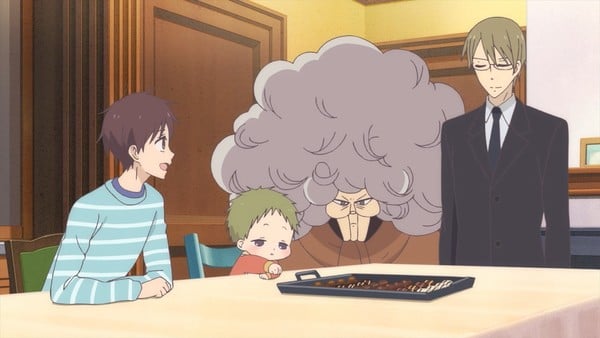
© 時計野はり・白泉社/「学園ベビーシッターズ」製作委員会
Gakuen Babysitters is a comfort anime for the ages. The lockdowns of 2020 must have done a number on my brain because I forgot this anime was released in 2018, not 2020. I have watched a clip or a full episode of Gakuen Babysitters anytime I need a pep in my step, and that’s a testament to the levels of serotonin this series has brought to my life. Its premise is straightforward as the slice-of-life anime focuses on the life of Ryuuichi Kashima and the children in the daycare part of his high school.
Every episode has one or two self-contained stories, some more emotional than others. However, there’s character development and overall plot progression as brothers Ryuuichi and Kotaro learn to adapt to their new normal after losing their parents in a tragic plane crash. Although the series lacks any notable moments for animation quality, each episode is consistent and mirrors the charm and simplicity of the source material. The muted, pastel colors help to provide a relaxing watch for the eyes, while the overall character designs easily communicate their unique personalities. Mina Oosawa, the character designer who adapted the manga art for the anime, has gone on to work on designs for other heartwarming series like Given and Tadaima, Okaeri.
Ryuichi and Kotaro are taken in by the matriarch of Morinomiya Academy, Yoko Morinomiya, on the condition that the Ryuichi help with the school’s babysitter center. The series’twelve episodes are a collection of various stories, such as a zoo field trip and Kotaro going on his first errand to deliver his brother’s lunchbox. To put it simply, cute preschoolers are always busy with the normal antics expected of schoolchildren.
Of course, it’s not only the children who care deeply for Ryuuichi. The parents also watch over the two orphaned brothers as an unofficial community, guiding them without being patronizing. Chairwoman Morinomiya, who also lost her son and daughter-in-law in the same plane crash, provides the brothers with tough love, which is undercut when Kotaro occasionally calls her hair “shaggy.”
There are no overarching stakes, though, I find it emotionally heart-wrenching to see young children in distress even if it’s relatively minor. For example, my heart simply breaks when Taka—the loudest and ‘brattier’ of the children—loses his beloved toy sword during a festival. Or, on a more serious note, when Kotaro attempts to jump into open water when he thinks his brother is drowning and cries in anguish when the mother of his classmates holds the toddler from doing so.
By the end of episode one, you’ll be emotionally invested in the well-being of Ryuuichi and Kotaro, which will extend to all the characters in the series. The lighthearted nature of Gakuen Babysitters leads you to forget that it revolves around a teenager and his four-year-old brother who lost their parents, and only have each other. Every episode provides a moving, overarching narrative, and shows simple moral lessons that kids can understand while including relatable subjects for adults. Like a father who fears his children are emotionally distant from him because of his busy work as an actor, or an emotionally insecure schoolgirl. Maria Inomata, Ryuuichi’s classmate, is a book-smart but socially awkward schoolgirl with a stern attitude. She bottles up her feelings of loneliness, which the children help unload and relax by simply being happy to see her. Gakuen Babysitters also dabbles into light romance but never goes anywhere with that subplot, as the number one person in Ryuuichi’s heart is his younger brother.
You’ll laugh and you’ll cry at this simple series about babysitting in a daycare center. Come forget your woes while watching a heartwarming anime with cute depictions of toddlers.
MrAJCosplay
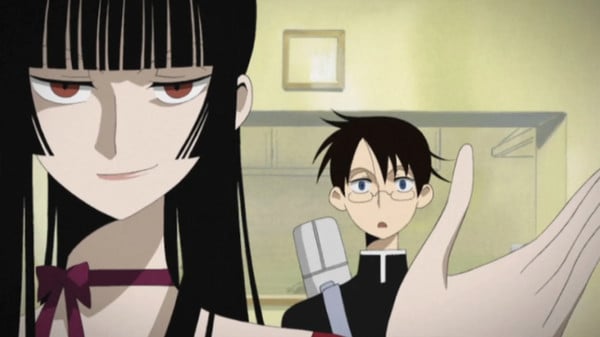
© 2006 CLAMP・講談社/アヤカシ研究会
There is a lot about xxxHOLiC that I think still holds up today. Just like how the title is a play on words with the xxx representing a blank space, and the rest of the title is a stand for addiction (for example, being an ALCOholic), the series is all about going through the miserable experiences that are afflicted on other people. Sometimes, these afflictions are random and circumstantial, while other times, they are self-imposed. There’s a strong emphasis on how words and language hold special meanings that can physically and spiritually affect others. Our main character, Watanuki, is somebody cursed to see horrific spirits that also find themselves attracted to him. All he wants to do is live a normal life. There’s this prevailing sense of misery throughout the show and while there are genuine moments of old-school comedy thrown in there for the sake of levity, almost every episode ends on a bit of a downer note. The series is episodic, going through different types of people who need help from our beautiful witch Yuko, who does her best to help. But I never walked away from an episode feeling happy. It’s more like a cold, hard truth gets revealed, and a lesson is learned, but that doesn’t necessarily mean the world gets brighter.
It makes sense that a show where words hold such power would have the dialogue and writing would be treated with such care. A major selling point of this show is Yuko and how she talks to those around her, particularly with our main character Watanuki. The writing is so tightly packed with comedic punch and plenty of wordplay that it doesn’t always translate well in the English version, but the effort is still there in trying to communicate the layered double meanings in a lot of the exchanges. There is a lot of exposition about spirits, but there’s also a lot of talk about the human spirit, destiny, and the power of choice. I’m glad these exchanges still hold up because the animation and art direction certainly have not.
Some gorgeous, aesthetic shots work perfectly as stills, and almost all of them have to do with Yuko. She is the definition of aesthetic, and the animation staff tries their hardest to ensure we, the viewers, understand that. But this animation style has not held up so many years later, outside of those shots and a few scant moments throughout the season. This is the show that I think about whenever somebody makes fun of the CLAMP art style with the incredibly long and lanky body proportions. These body types work for comedy, but so much of the show is dragged in serious melancholy that it gets incredibly distracting. The show is trying to combine real-world issues with supernatural influences and the art design doesn’t work in communicating that idea. The color palette emphasizes shades of brown and plenty of black with the illusion of very dim lighting across most scenes outside of the high school the main character attends. However, the character designs and movements are too cartoony to convey any major sense of realism. Everything looks so flat and lifeless.
At best, the show can look very messy, and at worst, it just looks very boring with a soundtrack that mostly exists as background noise outside of a few scant tracks, such as the themes that play when Yuko is present. In some ways, I almost think the show would work better as an audio drama where I can just listen to the characters describe everything taking place. Maybe that would’ve been a better way to consume it, or maybe the show would work a lot better if there was some kind of reboot with an updated aesthetic because other studios have shown that they can adapt the CLAMP art style incredibly well.
Bamboo Dong
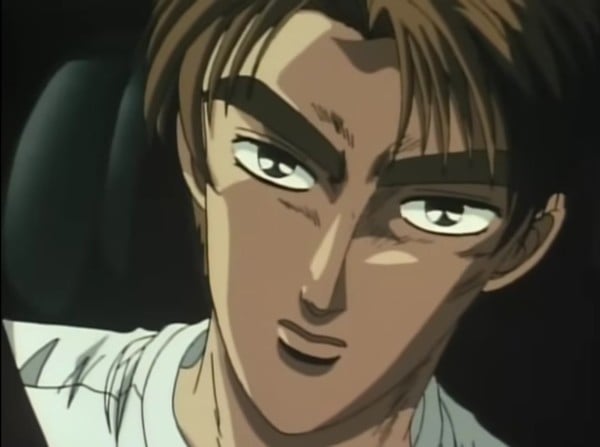
© 2003 Shuichi Shigeno/KODANSHA/prime direction/OB PLANNING
But the story! The story was pure perfection. It turned an entire generation of fans into street racing enthusiasts. Even if you didn’t care about cars, the tension of every episode kept you coming back for more. Initial D wasn’t just a sports anime—it was the story of an unlikely underdog whose coolness wasn’t even desired. It was just thrust upon him as a filial chore!
You see, the main hero of Initial D, Takumi Fujiwara, wasn’t even the chosen one. He was just a guy who had to deliver tofu for the family business in the early hours before school. And if you’ve ever had freshly made silken tofu, you know how delicate it is. That was the burden thrust upon Takumi, whose daily chore led his father—a racing legend back in his day—to teach Takumi the finely honed art of drifting. It’s a technique where drivers intentionally oversteer a car through a turn so that it skids sideways with the wheels turning in the opposite direction. It was also awesome that Takumi’s car was an underdog too.
Compared to the flashier, much more expensive cars driven by the other racers, Takumi’s ride was a Toyota AE86 Trueno, part of the Corolla lineup. On the straight-aways, it simply couldn’t compete with the fancier race cars, but on the turns? That’s where Takumi’s ridiculous and unbeatable skills shone. And yes, that’s the entire show. Sure, there are some side stories here and there about the people in his life, and he gets embroiled in several racing team spats and increasingly complex race courses, but at the end of the day, he always pulled ahead because he’s just a damned good driver.
The fact that this series became such an enduring cult classic despite its unfortunate character designs, clunky animation, and truly awful CG car animations is a pure testament to how magnificently the action was written. They probably could have animated the entire show with stop-motion Kleenex boxes, and it would have still been immensely thrilling—that’s how good the story is for Initial D. The classic Eurobeat soundtrack doesn’t hurt either.
Jairus Taylor
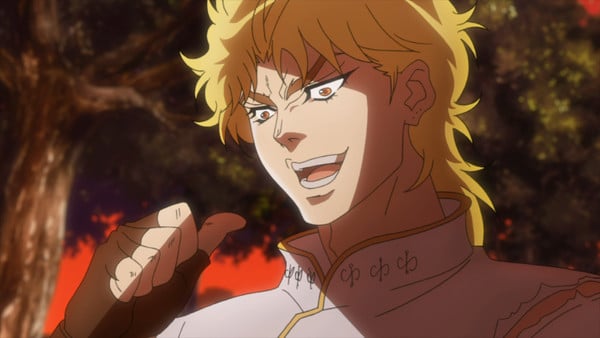
© 荒木飛呂彦/集英社・ジョジョの奇妙な冒険製作委員会
Before you all raise your pitchforks in protest, hear me out. Yes, Jojo has a pretty distinctive visual style, and yes, the quality of David Productions’work on the series has (mostly) gone up with each subsequent part that’s been adapted. However, that hasn’t always transferred over to its actual animation quality, especially so with its first season when David Productions was a much smaller studio. Going by their portfolio before 2012, they were a pretty strange pick to adapt a property like Jojo, as their biggest claims to fame at the time were titles like Inu x Boku S.S., Ben-To, and assisting Studio Pierrot with Level E. It’s not a terrible track record, but certainly not the one you’d expect when they were given the keys to one of the biggest and seemingly unadaptable manga franchises in Japan. As such, it’s not too surprising that the animation quality of Jojo’s first season is pretty inconsistent. While there are a couple of standout episodes on that front, the majority are merely passable compared to what you’d expect out of the adaptation of such a big title, and some of the shortcuts taken with action scenes make it feel more like watching a comic book in motion than a TV show. However, it speaks to the strengths of Kenichi Suzuki and his team that they were able to leverage that into a feature rather than a weakness, and compensating for production flaws by leaning into that comic book aesthetic is a great example of how direction and intent can be more important to the aesthetic of a show than raw animation quality.
Of course, it also speaks to how great Hirohiko Araki’s writing is, that it’s so easy to get swept into the series despite some of those shortcomings. The pseudo-Victorian drama that forms the basis for Phantom Blood is more entertaining than it has right to be. It’s fun seeing the conflict between British gentleman Jonathan Joestar and his newly adopted brother, Dio Brando, escalate from a battle for the family fortune to vampires versus humans with magic breathing. Dio contributes a lot to the appeal here, as he’s the kind of villain you love to hate, and both Takehito Koyasu and Patrick Seitz do a great job of chewing the scenery regardless of which language track you listen to. Whether he’s stealing the first kiss of Jonathan’s girlfriend Erina, or tricking a newly formed vampire into eating her baby, he’s so delightfully punchable that it’s hard not to be drawn in by his villainous antics. That energy gives the story a kind of goofy charm that’s impossible to look away from.
This goes double for Battle Tendency, which shifts into a style more akin to an Indiana Jones movie and sees Jonathan’s descendant, Joseph trying to prevent the resurrection of an ancient race of superhumans as he crosses paths with vampires and actual nazis along the way. However, while a lot of series survive on escalation, the real strength behind Jojo is in just how good Araki is at crafting melodrama out of even the most bizarre of circumstances. For as silly as things like Jonathan and Dio’s rivalry, or the tragic history of the Joestars can get, a lot of it manages to be genuinely compelling, and Araki knows how to squeeze the most out of even the most off-putting of characters (that Stroheim, is even tolerable despite being a literal nazi-cyborg speaks volumes). With all those strengths working together, it makes sense that this first season helped take Jojo from a property with little reach outside Japan, into a global powerhouse, and while this isn’t the best-looking entry in the franchise, it wouldn’t be where it is without it.
Kennedy
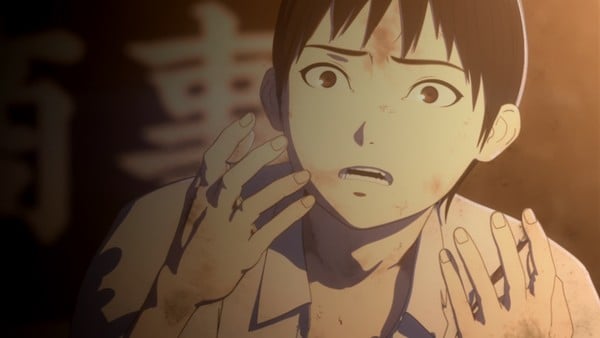
© 桜井画門・講談社/亜人管理委員会
Ajin is one of those shows where I couldn’t even form a sentai team with all the people I’ve met who’ve seen it. But few as they are, everyone I’ve ever encountered who’s watched Ajin thinks it’s fantastic. One of the first few inmates of what would eventually become known as “Netflix jail,” Ajin primarily follows a seemingly ordinary high schooler named Kei Nagai. He has two key things that set him apart: first of all, getting hit by a truck didn’t result in him getting isekai’d. He probably would’ve been better off if he had been because, secondly, despite being soaked in his own blood, he didn’t die—in fact, his body instantly healed itself. He didn’t realize it until now, but he’s an Ajin: a rare, immortal demi-human. Ajin is routinely subjected to a relentless, neverending onslaught of painful tests and experiments, so thus begins Kei’s new life on the lam.
But good as it is overall, this anime has some issues that are nothing if not visible—because most of them center around, well, the visuals. This TV anime from 2016 was animated entirely in CGI by Polygon Pictures (who, at the time, was fresh off the heels of Knights of Sidonia—another CGI, Netflix original anime). Now, does being animated entirely in CGI inherently make this show ugly? No. That being said, this isn’t exactly Land of Lustrous. Among other issues, figures (and especially the hair) tend to look a bit blocky, movements are choppy, and the color palette barely ever leaves the realm of neutral tones. Though, to be fair, I’ve seen way worse-looking CGI in anime, too (cough EX-ARM cough).
But once you get past the visuals, you’re left with one of the most thrilling “maybe humans are the real monsters”-stories in all anime. This anime has interpersonal drama, violent ghost fights, and the kind of tension that constantly keeps you at the edge of your seat, but more than anything, this anime has spectacle and plenty of it. And it’s often helmed by this anime’s shining star, the strategic and highly capable Ajin Satou.
Satou is the force of nature behind more or less everything that happens in Ajin—and oh, how shih-tzu-minus-the-zu hits the fan in this show. While things become more complicated the further this anime gets (but I don’t dare spoil it for you, so we’re going to leave it at that), for most of the show, he seems to be acting primarily out of a desire to see the suffering the Ajin are subjected to put to an immediate end—no matter what it takes. He stands in sharp contrast to Kei, who’s far from the altruistic hero that you might expect an anime like this one to follow. This unusual dynamic between the two main characters is fascinating and also makes this anime perfect for people who like a story where the protagonist isn’t necessarily a good person.
I think in 2016, the visuals and Netflix jail were the main two factors that kept more people from watching Ajin. But in 2025, Netflix has become a much bigger player in the anime industry than they were a decade ago. And the visuals—well, okay, fine, they haven’t aged all that well. Still, my point is that this anime has been massively overlooked, and a really big part of that has been because of how it looks. While I think the criticisms to be made about this anime’s visuals are fair (or at least the actual criticisms relating to the CGI itself, rather than the plain fact that it’s CGI), the show itself is nonetheless a fun watch, and I’m willing to die on this hill.
Knights of Sidonia
Kevin Cormack
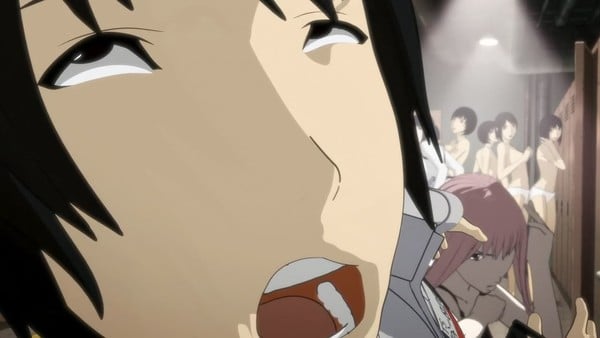
© TSUTOMU NIHEI・KODANSHA/KOS PRODUCT COMMITTEE
Back in 2014, I’m not sure what possessed Netflix to license a Polygon Pictures CG animated series as their first ever “Netflix Original Anime,” raising more than a few eyebrows among anime fans. At the time, Polygon was most recognized in the West for their contribution to US-produced animated shows Star Wars: The Clone Wars, Transformers Prime, and Tron: Uprising, all CG-animated shows that didn’t exactly scream “typical anime.” Similarly, the works of mangaka Tsutomu Nihei weren’t typically mainstream either. Even his most notable manga, the inscrutable but fascinating Blame!, had only received a seven-episode short ONA/OVA series in 2003.
Based on Nihei’s fifteen-volume manga series of the same name, Knights of Sidonia follows young male protagonist Nagate Tanikaze’s life in the gargantuan (29 x 5km) sub-light-speed seed ship Sidonia, a typically stark, alien Nihei setting. Having been raised in seclusion by his grandfather, deep in the bowels of the ship, following his grandfather’s death, Tanikaze finds himself as an outsider among the other, subtly posthuman, Sidonia residents.
One thousand years previously, the seemingly mindless alien “Gauna” entities destroyed the solar system, with humanity’s survivors fleeing in their huge concrete ships, expanding from the asteroids from which they were mined. To adapt, humanity developed the ability to photosynthesize (to reduce food requirements), while also maintaining population via cloning and asexual reproduction. One prominent character is a new, third sex, with the ability to choose between biological female and male sexual capabilities. The comparatively unaugmented Tanikaze struggles to assimilate while also being drafted into the military as a child soldier in the eternal war against the ever-pursuing Gauna.
Knights of Sidonia is a mecha show with fairly standard shonen action and romance filtered through Tsutomu Nihei’s deeply strange mind. Tanikaze finds himself embroiled in a weird love triangle between one of the aforementioned third sex characters, and a fifteen-meter-tall human/Gauna hybrid who interacts with other characters mainly in the form of a massive phallic tentacle. No one else does romance quite like Nihei, and that’s probably for the best!
Compared to the exemplary work of Studio Orange (BEASTARS, Land of the Lustrous, Trigun Stampede), Polygon Pictures’Knights of Sidonia looks jarringly janky. While the plentiful and kinetic mecha action scenes are incredibly detailed and dramatic, the character rigs and accompanying animation are hopelessly stiff and jerky. Faces are difficult to distinguish, with mask-like expressions that barely change, let alone emote. With a muted color scheme erring on the side of visually boring, it’s no wonder that many fans of more traditional 2D animation were repelled by Sidonia’s substandard presentation.
Beneath the surface, however, is a compelling story of a people driven to desperate measures to survive. Tanikaze himself isn’t that interesting a protagonist, but the surrounding characters are quirky and entertaining, such as the twenty-two-strong “Honoka series”, a group of cloned pink-haired sisters with accelerated growth and development. Sidonia also isn’t afraid to kill off or horrifically alter characters if it serves the plot, which isn’t at all predictable.
While its visuals can easily repel potential viewers, the soundtrack is superb, especially the first season’s pulse-pounding opener, and the dramatic, operatic score that accompanies battle scenes. After a six-year break following Sidonia’s second season, the story definitively concluded in the theatrical movie Love Woven in the Stars, which greatly compresses and alters the manga’s conclusion. Sidonia must have met with some measure of success for Polygon Pictures, because they subsequently produced a movie version of Nihei’s Blame! (which I also enjoyed), and the more recent Kaina of the Great Snow Sea (un?)fortunately using the same divisive CG approach.
Disclosure: Kadokawa World Entertainment (KWE), a wholly owned subsidiary of Kadokawa Corporation, is the majority owner of Anime News Network, LLC.本文提到的一家公司是Kadokawa集團公司的一部分。